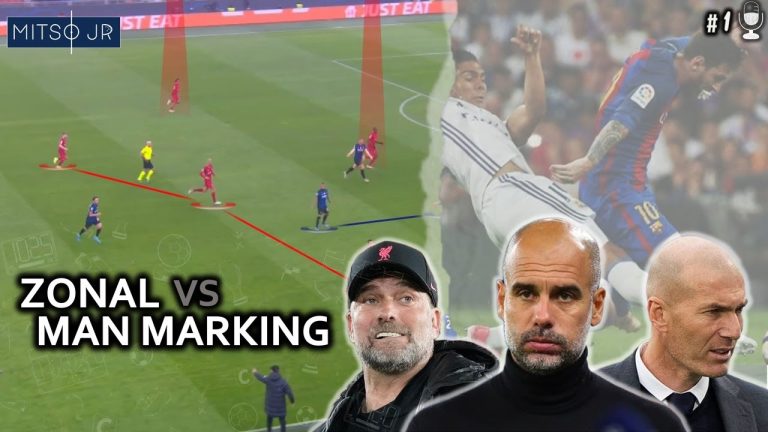In the world of football, defensive roles play a crucial part in the success of a team. One of the most popular defensive strategies employed by managers is the zonal marking system. This tactical approach requires players to defend specific areas of the pitch rather than marking individual opponents. While zonal marking can be highly effective in thwarting attacking moves, it demands a high level of organization, communication, and spatial awareness from defenders. In this article, we delve into the intricacies of defensive roles in zonal marking, exploring the key responsibilities of players and the strategies employed to counter the opposition’s attacking threats. Join us as we unravel the art of defending in this sophisticated and captivating defensive system.
- Flexibility in positioning: Zonal marking allows defenders to be more flexible in their positioning on the field. Instead of man-marking specific players, defenders can focus on maintaining their position within a designated zone. This helps create a more organized defensive structure.
- Collective responsibility: Zonal marking requires defenders to work together as a unit and take collective responsibility for protecting their assigned zones. This means that defenders need to communicate effectively and ensure that there are no gaps or spaces left open for opponents to exploit.
- Anticipation and interception: Zonal marking encourages defenders to anticipate the movements of opposing players and intercept the ball when it enters their designated zones. By reading the game and reacting quickly, defenders can cut off passing lanes and prevent the opposition from creating scoring opportunities.
- Zone coverage: Zonal marking allows defenders to cover larger areas of the field, which can be particularly effective against teams with quick and mobile attackers. By covering the zones rather than individual players, defenders can deny space and limit the attacking options of the opposition, making it harder for them to create goal-scoring opportunities.
What does zonal defending mean?
Zonal defending is a strategic system utilized in sports like basketball or football, where players are assigned specific areas to defend rather than individual opponents. This approach enhances team coordination and provides a robust defensive structure. By allocating responsibilities based on zones, players can react quickly to potential threats, block passing lanes, and prevent opponents from penetrating the defense. Zonal defending allows for seamless communication and teamwork among players, creating a unified front that can effectively thwart the opposing team’s attacks.
In zonal defending, players become the guardians of designated regions, forming an impenetrable shield against their adversaries. This defensive tactic not only optimizes defensive coverage but also fosters a sense of collective responsibility within the team. By focusing on securing areas rather than individual opponents, zonal defending enables players to anticipate and intercept plays effectively. This approach not only makes it difficult for opponents to find open spaces but also facilitates strategic decision-making, as players can adapt their positioning according to the flow of the game. Zonal defending thus serves as a powerful tool for teams aiming to neutralize offensive threats and maintain a solid defensive structure.
What does zonal marking mean in team defense?
Zonal marking is a revolutionary defensive strategy that focuses on controlling and defending spaces instead of individual players. By implementing zonal marking, teams can effectively neutralize the opposition’s attacking threats and maintain a strong defensive structure. Whether it’s during open play or defending set-pieces, zonal marking allows teams to work as a cohesive unit, ensuring maximum coverage and minimizing the risk of gaps in the defense. This strategic approach not only enhances the team’s defensive capabilities but also promotes effective communication and coordination among players, making it a formidable tactic in team defense.
In team defense, zonal marking offers a refreshing alternative to the traditional man-to-man marking. With zonal marking, players are assigned specific areas to cover rather than individual opponents. This approach allows for greater flexibility and adaptability, as players can adjust their positions based on the movement of the opposition. By strategically positioning themselves, defenders can effectively close down passing lanes and restrict the attacking options of the opposing team. Zonal marking not only requires strong tactical awareness but also emphasizes teamwork and communication, as players must constantly coordinate their movements to maintain a cohesive defensive structure. Overall, zonal marking is a dynamic and effective strategy that enhances team defense by prioritizing space control and promoting collective responsibility.
What are the distinctions between zonal defending and man-marking?
Zonal marking and man-marking are two distinct defensive strategies in football. Zonal marking focuses on teamwork, positioning, and anticipation, where defenders are responsible for covering specific areas of the field rather than individual opponents. This approach encourages players to work together, communicate effectively, and maintain a cohesive defensive structure. On the other hand, man-marking emphasizes individual defensive skills and one-on-one duels, as each defender is assigned to mark a specific opponent throughout the game. This strategy requires players to closely track their assigned opponent, disrupt their movements, and win individual battles. Both zonal marking and man-marking have their benefits and drawbacks, but they play crucial roles in the overall development of football players by shaping their understanding of defensive tactics and enhancing their skill sets.
Mastering the Art: Unleashing Defensive Power in Zonal Marking
Paragraph 1:
In the realm of football tactics, zonal marking has emerged as a powerful defensive strategy, providing teams with a solid foundation against opponents. By assigning players specific areas of the field to defend rather than marking individual opponents, teams can effectively cover large spaces and prevent gaps from opening up. Mastering the art of zonal marking requires a deep understanding of positional play, coordination, and communication amongst defenders. With this approach, teams can unleash a formidable defensive power that can stifle even the most potent attacks.
Paragraph 2:
The key to successfully implementing zonal marking lies in the ability to maintain a compact and organized defensive structure. Defenders must constantly be aware of their positioning relative to their teammates and the spaces they are responsible for. By constantly adjusting their positions, defenders can deny the opposition time and space to execute their attacking moves. This proactive approach not only restricts the opponent’s options but also increases the chances of intercepting passes or regaining possession. The art of zonal marking lies in this delicate balance between staying disciplined and adapting to the ever-changing dynamics of the game.
Paragraph 3:
To unleash the full potential of zonal marking, effective communication is essential. Defenders need to constantly communicate with each other, providing updates on the positions of opponents, potential threats, and gaps in the defensive structure. This ensures that every player is on the same page and can make quick decisions based on the information at hand. Furthermore, coordination between the defensive line and midfielders is crucial to maintain a unified front and prevent opponents from exploiting the spaces in between. By mastering the art of zonal marking, teams can transform their defense into an impenetrable fortress, frustrating their opponents and gaining a significant advantage on the pitch.
Strategic Dominance: Unlocking the Defensive Potential of Zonal Marking
Strategic Dominance: Unlocking the Defensive Potential of Zonal Marking
In the ever-evolving world of football tactics, zonal marking has emerged as a powerful defensive strategy, capable of unlocking a team’s true potential. By assigning each player a specific zone rather than man-marking opponents, teams can effectively neutralize threats and maintain a compact defensive structure. This approach not only minimizes the risk of individual errors but also allows players to anticipate and intercept passes, stifling the opposition’s attacking play. With zonal marking, teams can achieve strategic dominance on the field, creating a solid foundation for success and thwarting even the most potent offensive threats.
In the realm of modern football, the implementation of zonal marking has revolutionized defensive roles on the field. By strategically assigning players specific zones to cover, teams can effectively neutralize attacking threats and maintain a strong defensive structure. From meticulously positioning themselves to intercept passes to seamlessly closing down spaces, defenders in zonal marking systems have proven their ability to thwart opponents’ advances. With its emphasis on collective responsibility and spatial awareness, zonal marking has undoubtedly become a vital tool in the arsenal of any successful defensive unit.



